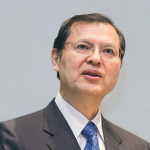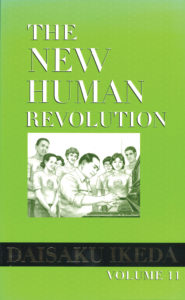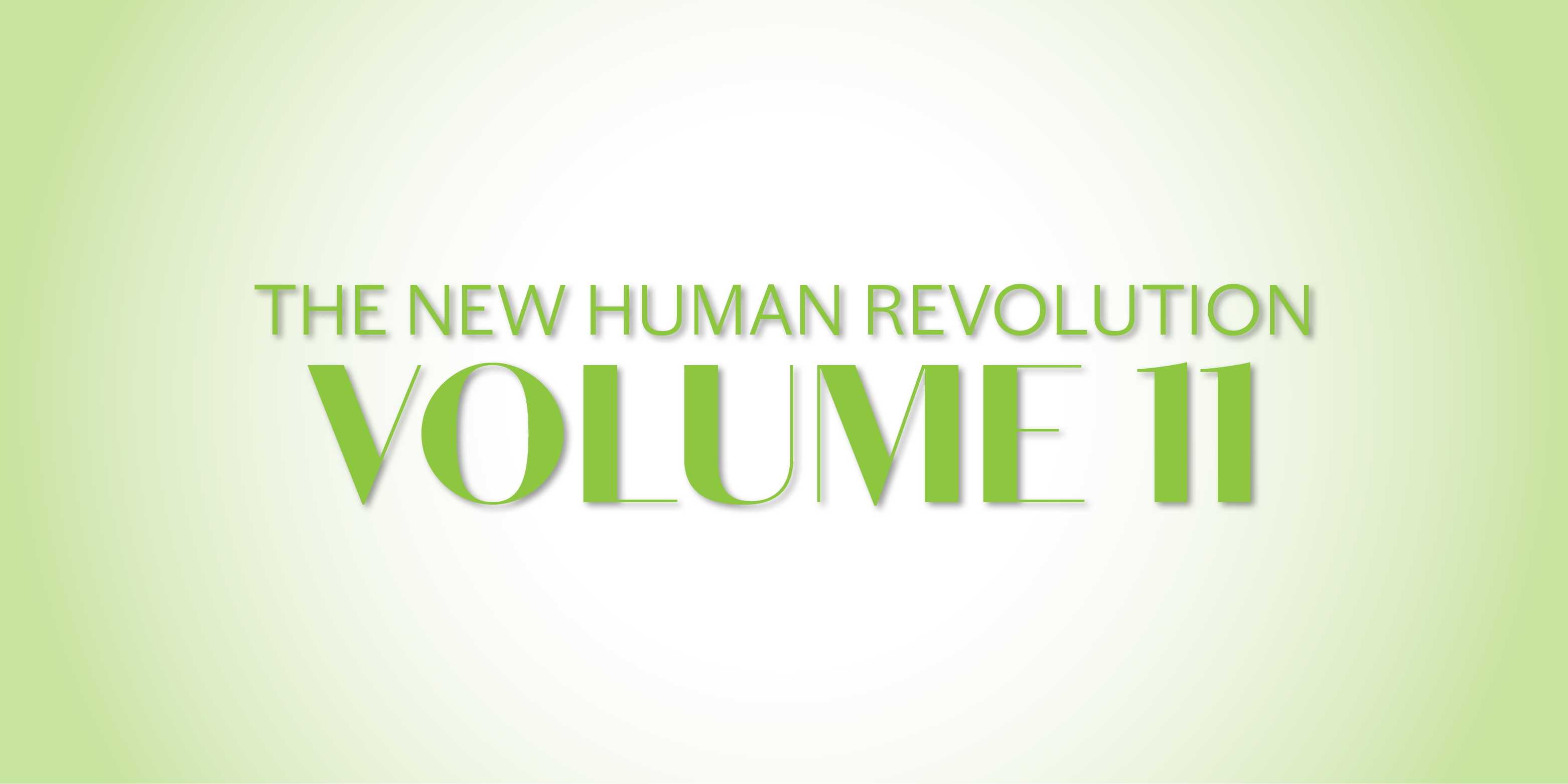 On September 8, 2019, the construction of the Soka Gakkai World Seikyo Center was completed at the Soka Gakkai Headquarters Complex in Shinanomachi, Tokyo. The day marked exactly one year since the publication of the final installment of The New Human Revolution.
On September 8, 2019, the construction of the Soka Gakkai World Seikyo Center was completed at the Soka Gakkai Headquarters Complex in Shinanomachi, Tokyo. The day marked exactly one year since the publication of the final installment of The New Human Revolution.
At the entrance of the World Seikyo Center stands a stone monument bearing a plaque with a dedication written by SGI President Ikeda. The dedication, dated September 8 and titled “Seikyo Shimbun[1]—The Triumph of Mentor and Disciple,” begins:
Kosen-rufu is a struggle of words. The Soka Gakkai’s development hinges on the power of words to communicate boldly the true greatness and validity of Nichiren Buddhism.
The “Light of Dawn” chapter of volume 11 of The New Human Revolution describes a scene where, in 1966, Shin’ichi Yamamoto speaks with a leader in Brazil about what this “struggle of words” entails:
The situation here in Brazil requires a concentrated effort by members to convey a correct understanding of the Soka Gakkai in Brazilian society. This can’t be achieved, however, simply by writing articles for Soka Gakkai publications. The most important thing is to use your voice and conduct dialogue with others … The best way to do this is for each member to go out and make an effort to speak clearly and honestly to their fellow citizens about the correctness of Buddhism and our organization.[2]
In concrete terms, then, kosen-rufu is about engaging in heart-to-heart dialogue and gaining wider understanding of the Soka Gakkai through reaching out and connecting with others.
In the World Seikyo Center dedication, President Ikeda also mentions that through sister publications of the Seikyo Shimbun, which share its mission of imparting a light of wisdom to the world, the message of this newspaper for the people is now able to reach readers across the globe simultaneously.
In the “Pioneering New Frontiers” chapter, Shin’ichi Yamamoto proposes that the Soka Gakkai organ newspaper in Peru be named Peru Seikyo. Today, more than 80 such sister publications of the Seikyo Shimbun can be found in 50 countries and territories worldwide. At this significant time, with the World Seikyo Center to be opened on November 18, let’s courageously challenge ourselves to have one-to-one conversations about Buddhism with our friends, using the Seikyo Shimbun to help us.
The Driving Force to Change the Times
The “Light of Dawn” chapter details the struggles of the members in Brazil under its military dictator-ship at a time when misconceptions about and prejudices toward the Soka Gakkai were circulating in society. In order to overcome these, Shin’ichi makes efforts to meet with journalists in Brazil. He also encourages fellow members so they may establish an unshakable foundation of faith in their lives, saying:
To struggle against hardship is the direct path to our personal development and elevating our state of life. It is a springboard that leads to our human revolution.[3]
Brazilian members set out to win trust in society starting from earnest prayer, with the women’s division members taking the lead. In this chapter, Shin’ichi shares the following with a local women’s division leader:
The real driving force to change the times is the prayers of women and their activities that are deeply rooted in daily life. The power of women can be likened to the power of the earth. When the earth moves, everything is affected.[4]
This women’s leader, originally from Japan, proceeds to chant Nam-myoho-renge-kyo with a fierce determination each day. She would then travel 20 to 30 miles almost daily to visit members, clasping a list of their addresses in her hand and asking for directions in broken Portuguese along the way. Through such valiant and earnest efforts, members determined to work for kosen-rufu begin to appear one after another in Brazil.
Their shared commitment is expressed in their motto “Muito mais daimoku!” (“More daimoku!”) which is the heartbeat of SGI-Brazil (BSGI) to this day. The spirit and struggle of the pioneer members still live on.
The first Soka Gakkai chapter outside Japan was established in Brazil during Shin’ichi’s first trip there in October 1960. Later, chapters are established in other Latin American countries such as Peru, Bolivia, Paraguay, Argentina and the Dominican Republic. The “Pioneering New Frontiers” chapter details how the Soka Gakkai grows in recognition in these countries, which historically had no connection to Buddhism.
In the beginning, members in each of these countries undergo a succession of trials and tribulations, which are “not unlike trying to cultivate rocky earth in order to grow crops.”[5]However, the members gradually earn trust in society through their contributions as model citizens.
The genuine bond they had formed with Shin’ichi is what serves as the primary motivating force behind their efforts. When Japanese leaders visit Argentina, Shin’ichi asks them to convey this message to the members there:
While Japan and Argentina may seem a world apart, on opposite ends of the earth, the hearts of those who live their lives for kosen-rufu are one with mine. You are always in my heart.[6]
We must never forget the intense struggles of our pioneer members and their passionate spirit born out of the heart-to-heart connection they forged with their mentor. The mentor-disciple spirit is not based on physically meeting the mentor. Rather, it comes alive when the disciples earnestly strive to fulfill their shared vow, with the mentor in their hearts.
Marking the End of the 20th Century
Volume 11 was published in daily installments in the Seikyo Shimbun toward the end of the 20th century, from May to December 2000. In the “Dynamic Advancement” chapter, Shin’ichi Yamamoto describes the century as “a time of ceaseless war and conflict,”[7] and the “Ever-Victorious” chapter provides a detailed account of events surrounding the Vietnam War.
By 1966, the Vietnam War had become a seemingly endless quagmire. Shin’ichi discusses the war and the urgent need to bring it to an end at a Tokyo metropolitan area high school division meeting in January that year, as well as at a youth division general meeting in November and at a student division meeting in August 1967. While anticipating pressure from Japanese politicians who toed the U.S. line, he continues to appeal for peace in Vietnam and presents proposals for resolving the conflict out of his sincere concern that “young people are the first to die in war, and innocent civilians are war’s greatest victims.”[8]
Youth division members in the United States show a great response to his proposals as many of them are either faced with being drafted or are career soldiers already. Convinced that Buddhism is a teaching that can eliminate war from the world, they eagerly study Nichiren Daishonin’s writings and Shin’ichi’s lectures. As they pursue their studies, they come to this conclusion:
The fundamental path to peace can only be found in transforming the inner state of life of each individual. In other words, the only answer is human revolution, a process that establishes an indestructible citadel of peace in each person’s heart.[9]
Their response clearly demonstrates the essential attitude of Buddhist practitioners.
In January 1973, Shin’ichi sends a letter to the U.S. president appealing for a ceasefire. It is at once “a proposal and a pledge for peace, as well as an admonition”[10] coming from his irrepressible conviction that we must transform the century of war that we saw in the 20th century into a century of peace in the 21st.
This spirit is certainly reminiscent of Nichiren when he submitted “On Establishing the Correct Teaching for the Peace of the Land” in remonstration with the government. At the end of the “Dynamic Advancement” chapter, I believe President Ikeda writes about the persecutions undergone by the Daishonin as an expression of his determination to transmit and put into practice his spirit in the 21st century.
Unperturbed by any manner of adversity, let us keep advancing in exact accord with the Daishonin’s spirit to further expand our movement for kosen-rufu.
Translated from the September 25, 2019, issue of the Seikyo Shimbun, the Soka Gakkai’s daily newspaper.
Summary of Contents
 Light of Dawn
Light of Dawn
In March 1966, Shin’ichi Yamamoto visits Brazil. Under strict police surveillance, he encourages the members to build trust in society, thus laying the foundations for kosen-rufu.
Pioneering New Frontiers
Shin’ichi travels to Peru and highlights the members’ efforts in four other South American countries including Argentina.
Ever-Victorious
The Kansai Culture Festival is held despite a downpour. Shin’ichi issues a proposal calling for peace in Vietnam.
Dynamic Advancement
The Clean Government Party (Komeito) achieves success contesting Lower House elections for the first time. In Niigata, Shin’ichi honors Nichiren Daishonin’s life and his perseverance in the face of persecution.
This book is available at https://bookstore.sgi-usa.org.
You are reading {{ meterCount }} of {{ meterMax }} free premium articles

